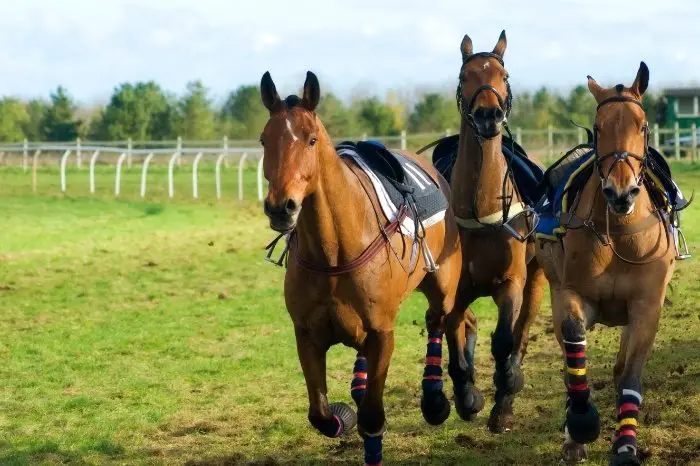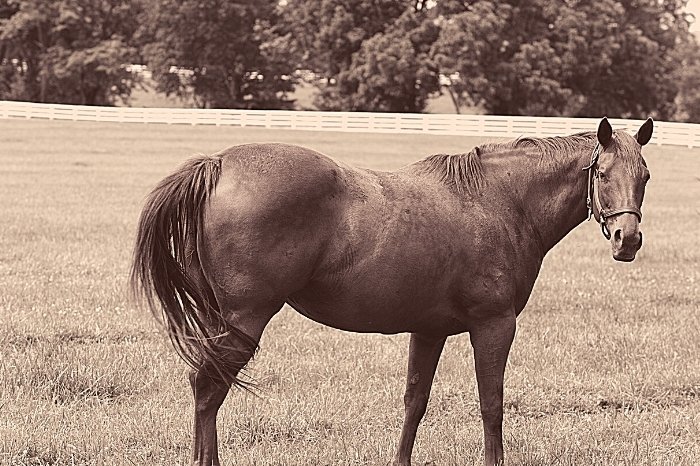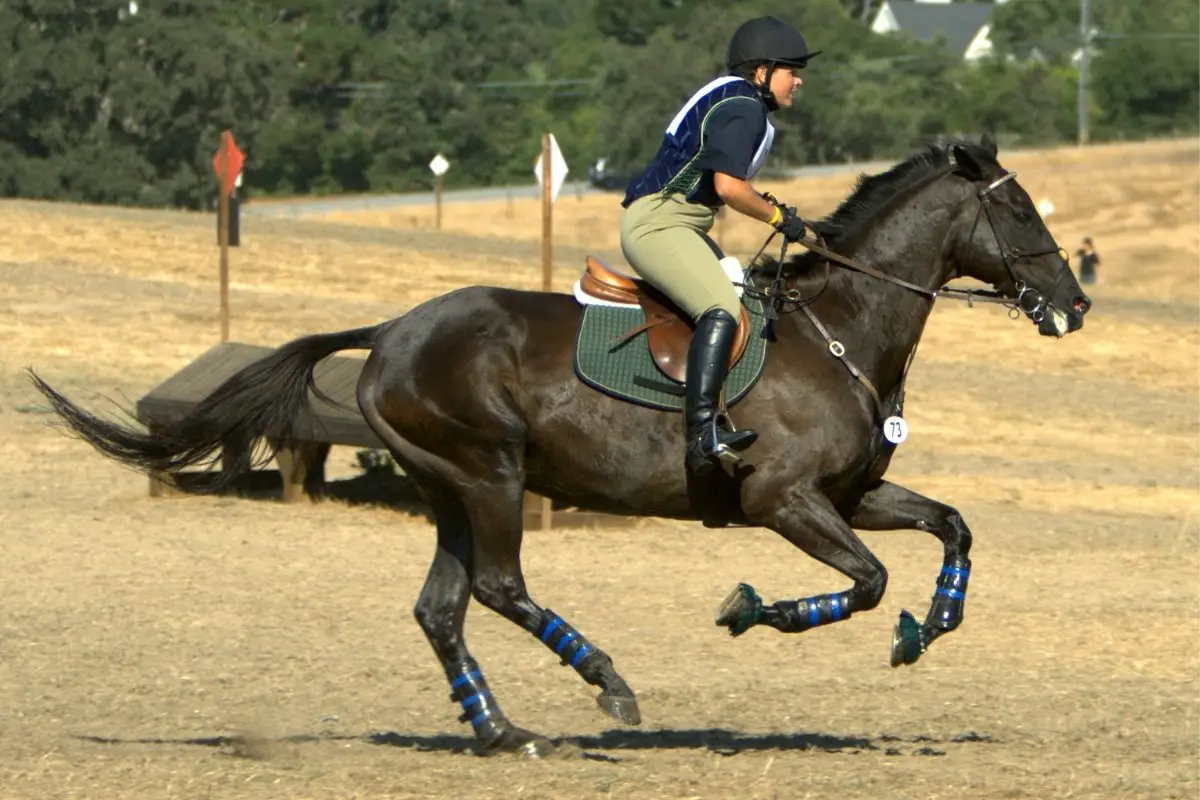Last Updated on March 15, 2022
Horses run much faster than humans, even an old one can outrun you, but one type of horse can gallop quicker than any other, so what is the racehorse top speed? The majority of racehorses are Thoroughbreds, but Quarter Horse racing is also quite common. Here we will explore just how fast these magnificent horses can go.
Racehorse Top Speed
The average speed of a galloping horse is 30 miles per hour. But the top speed of a racehorse is much higher. The fastest speed ever recorded by a racehorse is 43.97 miles per hour.
This record, confirmed by the Guinness Book of World Records goes to Winning Brew. A just two years old, Winning Brew, ran at the Penn National Race Course in 2008 setting this impressive speed. She did not go on to have an illustrious racing career, like other legendary horses.
Winning Brew’s record is significantly faster than the average speed of the Kentucky Derby winner. The average Kentucky Derby wins with a speed of 37 miles per hour. Even the great Secretariat never broke the 40 miles per hour mark, winning the Kentucky Derby with a speed of 38 miles per hour.

American Quarter Horse
Another type of racehorse is the Quarter Horse. This breed has an excellent ability to accelerate quickly. They race over a distance of a quarter of a mile, whereas Thoroughbreds usually race longer distances.
Over this shorter distance, the Quarter Horse top speed is faster than a Thoroughbred. The fastest ever speeds clocked by a Quarter Horse is 55 miles per hour, faster than the speed limit on many roads!
Read more about Why Is A Quarter Horse Called A Quarter Horse?
What Determines Racehorse Speed
Several factors influence the horses’ top speed. The confirmation of the horse, its muscle formation, and stride length have the biggest impact. The height of the horse does not always translate into a faster horse.
Research into the great racehorse Eclipse found that he was average in all aspects. He was not too tall or short, or big-bodied. One thing they did conclude is that Eclipse was a very balanced horse.
The Horse Conformation Handbook
To see some proof that height is not very important, just look at the racing legend Seabiscuit. Seabiscuit took the racing world by storm, winning several races, including a match race against the 1937 Kentucky Derby winner, War Admiral. This mighty little horse stood at only 15 hands tall.
X-Factor
The X-Factor when talking about racehorses, is not about their star power, though these horses have that too, it is all about the heart. The theory about horses with a larger heart accomplishing more on the racetrack dates to 1789 when Eclipse died.
During the postmortem, the surgeon discovered that Eclipse’s heart was twice the size of the average horse. The average horse’s heart weighs 7 pounds, while Eclipse’s weighed 14 pounds.
Several decades later, in 1989, when one of the greatest racehorses of all time, Secretariat, died, the autopsy left the surgeons stunned. Dr. Thomas Swerczek, a pathologist at the University of Kentucky, said at the time “We just stood there in stunned silence,” “There were no problems with it. It was just this huge engine.” The estimated weight of the Secretariat’s heart is 22 pounds.
The doctor, says it is this heart that explains how Secretariat won the Belmont by such an incredible lead. The Australian champion racehorse Phar Lap, also had a heart two times as big as the average at 14 pounds.
But it was Secretariat’s heart size that led to research into the X-Factor. The research found that this heart size is genetic and passes from the mother to her foal. Only the X chromosome can pass this gene on.
Pocahontas
After this discovery researchers traced family lines all the way back to the 1800s. All the lines go to one mare, Pocahontas, an English Thoroughbred. Pocahontas lived in England in 1837 and is a descendant of Eclipse. Both Secretariat and Phar Lap descend from Eclipse.
Spillett is the dam of Eclipse and is responsible for giving him the big heart gene. This theory explains why Secretariat did not produce the same results as a stud, but what he did do was produce fantastic daughters who went on to breed winners.

This large heart gave these horses an advantage on the racetrack. It allows the horse’s body to pump more oxygen, giving it more stamina and speed. The X-Factor is found in many of history’s greatest racehorses, including, War Admiral, Man O’War, Seattle Slew, Northern Dancer, and Citation.
Researchers are still trying to unlock the genetic marker for the X-Factor.
Fastest Race Horse Conclusion
As you can see the racehorse top speed is impressive, even without the X-Factor. The X-Factor is a fascinating subject that explains those horses in history that reach legendary status. Do You have a favorite racehorse from history?
Read more about The Wild Wests Most Famous Women Cowgirls
What makes a racehorse fast?
Horses are very well vascularized, meaning there are lots of blood vessels going to large muscle groups, providing them with a large supply of oxygen. This gives them the ability to generate high levels of force quickly, making them well suited for sprinting and jumping. They are also capable to run for extended periods of time without getting tired.
If you look at an anatomy of a horse, you will see that they have huge muscles. This is because horses need to be able to generate a lot of force quickly in order to jump and run. Their bodies are also very flexible, allowing them to reach very high speeds. However, when it comes to the equine world, speed is not always the best indicator of athletic performance. Many sports such as endurance racing, dressage, and show jumping focus on the ability of the horse to perform repetitive actions over long distances. This makes speed an important trait, but not necessarily one that will lead to success in these sports.
Is a Thoroughbred faster than an Arabian?
The Thoroughbred racehorse is the fastest horse in the world. The Quarter horse comes in the second place and the Arabian is the third fastest. In reality they are all very fast, what actually makes the difference is their endurance.
The horses that are used for racing are very important to the breeding industry. Breeders will only select the most suitable horses for their particular needs. The most famous of these is the Thoroughbred horse. A Thoroughbred horse is a horse whose ancestors are descendants of the horses that were bred by the Spanish, who brought them to England during the reign of King Henry II in the 13th century. These horses have been bred with the purpose of running and winning races so it’s no surprise they are still holding this precious title of the fastest horse breed in the world.
How fast are Andalusian horses?
Andalusians are a breed of horse that originate from the Iberian peninsula and are commonly used for racing. These horses can reach speeds of 55 miles per hour.
The Andalusian breed was developed in Spain from the Arab horse. It has been around since the Middle Ages. The breed was named after the region where they were originally bred. The Andalusian is one of the most popular breeds of horse in the world due to its beauty and speed. It is strong, compact, and graceful in its movements, with a long elegant tail and mane. However, despite its beauty, it is also known to have a fiery temper and strong will. This breed of horse is said to be an extremely difficult horse to train because it is very intelligent. When it comes to racing, the Andalusian is considered one of the most exciting horses to watch, thanks to its incredible athleticism.
How fast can a horse gallop with a rider?
Most people believe the Pony Express riders were at full gallop from the moment they departed Sacramento until they arrived in St. Louis. However, the average speed of a Pony Express rider was about 10 mph. That means that most of the ride they did either trot at about 8-9 mph or canter at 12-13 mph. The maximum distance that a Pony Express rider could travel in one day was 120 miles. The Pony Express had its heyday between 1860 and 1861. During that period, about 5,000 Pony Express riders rode the route across the United States.
Michael Dehaan is a passionate horse owner, horse rider, and lover of all things equine. He has been around horses since he was a child, and has grown to become an expert in the field. He has owned and ridden a variety of horses of different breeds, and has trained many to compete in shows and competitions. He is an experienced horseman, having worked with and competed many horses, including his own. He is an active member of the equestrian community, participating in events and teaching riding lessons.


